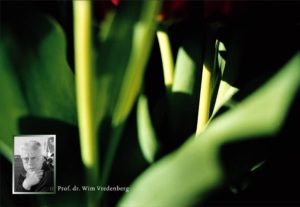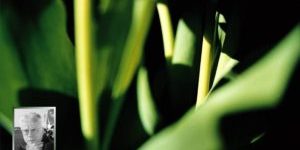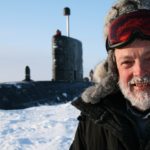Wim Vredenberg – CV & Research
No Comments yet Home address
Home address
Willem J. Vredenberg
Pr. Hendrikweg 2A
NL 6721 AD Bennekom
Tel. +31 318-430303
E-mail wim.vredenberg@wur.nl
Personal data
Date of birth
7 March 1937
Qualifications
“doctorate” experimental physics, mathematics and applied mathematics, University of Utrecht, 1960
PhD Biophysics, thesis ‘Spectrophotometric Studies on Primary and Associated Reactions in Photosynthesis, University of Leiden, 1965 (promotor Prof Dr L.N.M. Duysens)
Full Professor of Plant Physiology (physical aspects), WAU, 1979
Career
1960: junior scientist Biophysics Department University Leiden
1967: principal scientist Center for Agrobiological Research, Wageningen
1970: visiting lecturer Dept Physiology and Biophysics University of Illinois, Urbana, USA (1 year)
1979: professor of Plant Physiology (physical aspects) WAU
Membership of Professional Organizations
Nederlandse Natuurkundige Vereniging
Vereniging voor Biofysica, Chairman 1988-1994
American Society of Plant Physiologists
European Society of Biophysicists
Commissie Biochemie Biofysica van de KNAW 1986-1994
Biologische Raad van de KNAW 1990-1994
Editor Photosynthetica
Research programs
Achievements
From 1979 till 1994(5) the chair of (biophysical) plant physiology at the Wageningen Agricultural University (since 2000 renamed as Wageningen University and Research (WUR)) has focused its research primarily on the interaction of plants with light as a source of energy (photosynthesis) and of information (photomorphogenesis), with special emphasis on the molecular, (bio-)physical and (eco-) physiological aspects thereof. After the merging in 1993 of the till then existing two physiological departments in the new department of Plant Physiology, the emphasis of the chair has become limited mainly to the field of photosynthesis. Research on photomorphogenesis) is now continuing within the research theme Regulation and Differentiation.
Research projects on photosynthesis have been:
Electrogenesis, energy trapping and energy coupling in chloroplasts.
The chloroplast is a perfect model of a photoelectric energy transducer. Changes in the photocurrent profiles (amplitude, rate constant) caused by single turnover or continuous energisation point amongst others to changes in conductance of longitudinal lumenal and stromal phases of the intensity folded thylakoid membrane system. They are found to be accompanied by changes of the internal chloroplast structure as concluded from EM micrographs. The dynamic properties of the thylakoid are apparently of importance for spatial distribution of generated currents and consequently for the bioenergetic performance of the plastid.
Transit sequence-triggered responses in chloroplast envelope membranes
The project aims at getting information on the nature of the membrane responses that are associated with and/or involved in the recognition and following translocation of the precursor across the envelope.
Photosystem II of photosynthesis in chloroplasts
Photosystem II not only selectively senses but also adapts efficiently to environmental stressors. Study of photometric properties of PSII in vivo (fluorescence, luminescence, absorption) offers a sensitive means to study the impact of and defensive strategies of plants against environmental factors (coordinated by Dr. J.J.S. van Rensen)
UV-B interaction with plants
Research focusses on three aspects of this interaction (i) identification of protective mechanisms,(ii) elucidation of the role of protective mechanisms in plant and ecosystem productivity, and (iii) PSII as a target for UV-B radiation
Regulation of photosynthesis in vivo
Modelling of photosynthetic light- and dark reactions and their feed-back interactions is used as a means to simulate the potential and time response of energy production Photosynthetic energy conversion in phytoplankton
The efficiency of photosynthesis, as measured with chlorophyll fluorescence, is documented to be a good measure for the efficiency of CO2-uptake or O2-production in (a population of) marine algae and cyanobacteria. (coordinated by Dr J.F.H. Snel)
Current Research and Prospects
After the expiration of the chair of plant physiology (physical aspects) in 1998 the biophysical research on the key role of the photosynthetic membrane in primary and secondary energy conversion reactions is continued on a free lance basis (so- called 0.0 appointment) and carried out in cooperation with the biophysical research groups in Moscow (Alexander Bulychev) and in Trebon ( Ondrej Prasil) and Novy Hrady (Lada Nedbal).
Renewed focusing on fluorescence measurements and techniques has been (re-)started by me in the late 90’s when photocurrent measurements with single turnover excitations in dark adapted intact chloroplasts showed evidence for photo-electrochemical control of the fluorescence yield of photosystem II (Bioelectrochemistry 54, 2001, 157-168). A new theoretical three-state trapping model (TSTM) of PS II was developed and applied to allow quantitative analysis of fluorescence (and photo-electrical) behavior in intact leaves, for which current ‘classic’ views, models and interpretations are inadequate. TSTM can do the job properly with relevant physical and physiological parameters. The model is described extensively in chapter 6 in the handbook ‘Çhlorophyll fluorescence: a signature of photosynthesis’ (eds. Govindjee and George C. Papageorgiou), Springer Dordrecht, the Netherlands (see Bibliography).
Using twin single turnover flashes (TTFs) we have found that the fluorescence increase in plant choroplasts induced by the first twin-partner is followed by an increase of approx. similar size when the second partner is applied within 30 to 100 µs after the first one. The amplitude of the twin response, the maximum of which corresponds with Fv/Fm ~ 0.8, shows a pronounced 4-periodic oscillation associated with the 4-step oxidation of water in the Kok cycle (S states) and titrates with a life time of a trapping competent state of 200 to 300 µs.
Our results demonstrate that PSII acts as a two photon trapping entity This has far-reaching consequences for current views on so called intersystem energy transfer (connectivity) between PSII units and on PSII heterogeneities with amongst others characteristics and properties of functional PSUs different in antenna size or electron transport activity. It is anticipated that double exciton- and electron trapping in PSII is advantageous for the plant. It serves the depression of electron transport in QB-nonreducing RCs, associated with electrochemically coupled proton transport, by an increased electron trapping efficiency in these centers (see Bibliography).
Some key refereed papers (1996-2006)
Voorthuysen, T. van, H.A. Dassen, J.F.H. Snel and W.J. Vredenberg Patch clamp study on flash?induced secondary electrogenic transport in the thylakoid membrane: Interpretation in terms of a Q?cycle/semiquinone cycle Biochim. Biophys. Acta 1277, 1996, 226?237.
Van den Wijngaard, P.W.J. and W.J. Vredenberg, A 50-picosiemens anion channel of the chlorolast envelope is involved in chloroplast protein import. J.Biol. Chem. 272 (1997) 29430-29433
Vredenberg, W.J., J.F.H. Snel and J.H.A. Dassen. A sizeable decrease in the electric conductance of the thylakoid lumen as an early event during reaction center and Q cycle turnover. Photosynthesis Res. 1998, 58, 111-121
Vredenberg, W.J.. A three-state model for energy trapping and chlorophyll fluorescence in photosystem II incorporating radical pair recombination. Biophys. J. 79(1), 2000, 26-38
(http://www.biophysj.org/cgi/reprint/79/1/26)
Vredenberg W.J. and Bulychev A.A. (2002) Photo-electrochemical control of photosystem II chloroplhyll fluorescence in vivo. Bioelectrochemistry 57: 123-128
Vredenberg W.J. System Analysis and Photo-Electrochemical Control of Chlorophyll Fluorescence in Terms of Trapping Models of Photosystem II: A Challenging View, in: Papageorgiou, G. and Govindjee (eds) Chlorophyll Fluorescence: A Signature of Photosynthesis, Springer, Dordrecht, the Netherlands , (2004). – p. 133-172
List of invited reviews/ proceedings/bookchapters
Struik, P.C., W.J. Vredenberg, J.A. Renkema, and J.E. Parlevliet, eds. Plant production on the threshold of a new century. Kluwers Academic Publishers, Dordrecht, The Netherlands, 1993, ISBN 0?7923?2903?1, 1
Vredenberg, W.J. Electrogenesis in the Photosynthetic Membrane: fields, facts and features Bioelectrochem. Bioenerg. 44 (1997) 1-11
Snel J.F.H. and W.J.Vredenberg The electrochemical properties of the thylakoid membrane in: Photosynthesis and Plant Biology (eds. G.S. Singhal, G.Renger, S.K. Sopory, K.-D Irrgang and Govindjee) – New Delhi: Narosa Publishing House 1999 p. 364-385.
Bulychev A.A. and W.J.Vredenberg Light-triggered electrical events in the thylakoid membrane of plant chloroplasts. Physiol. Plant. 105,1999, 577-584
Vredenberg, W.J. System Analysis and Photo-Electrochemical Control of Chlorophyll Fluorescence in terms of Trapping Models of Photosystem II in :Chlorophyll fluorescence: A Signature of Photosynthesis Eds: George C. Papageorgiou and Govindjee, Advances in Photosynthesis and Respiration Series, Springer, Dordrecht, the Netherlands , (2004). – p. 133-172
International cooperations
Research Cooperation Russia and The Netherlands (NWO-program 047.01.008.96)
Program: Diagnostics of Photoelectric Phenomena in Plant Chloroplast Membranes in Relation to Photosynthetic Biomass Production
Participants:
Moscow State University, Biophysics Department
Russ. Acad. Sci., Laboratory of Membrane Biophysics, Institute of Photosynthesis, Puschino
Moscow I.S. Sechenov Medical Academy, Department of Medical and Biological Physics
Joint Research with Biophysics Groups in Czech Republic (partly financed by the Academy of Sciences of the Czech Republic and by the Grant Agency of the Czech Republic)
Program: Fluorescence Kinetics in Single Turnover Flash Trains of variable Length and Frequency in Plant Chloroplasts
Participants:
·University of South Bohemia, Faculty of Biology , Ceske Budejovice,
·Inst. of Microbiology, Academy of Sciences Czech Republic, Laboratory of Photosynthesis, Trebon, Czech Republic
Institute of Physical Biology of the University of South Bohemia, Nove Hrady
You May Also Like
Comments
Leave a Reply



